Costa Rica is one of Latin America’s superstars. Packed with tropical landscapes, to-die-for beaches, and unparalleled biodiversity, this country might well be named paradise.
I wouldn’t be lying when I said that Ticos (Costa Ricans) are also some of the most welcoming people you’ll find, with their hospitality and friendliness second to none. There’s a lot to love in this country.
Whether you’re a wildlife enthusiast eager to explore the dense jungles, a solitude seeker yearning for tranquil escapes, or an adventure enthusiast seeking an adrenaline rush, Costa Rica offers an array of experiences that cater to every wanderer’s whims.
I spent a month heading far and wide across Costa Rica and have pulled together my absolute favorite destinations into these three one-week itineraries.
Each itinerary unveils a different facet of Costa Rica’s enchanting beauty, where you’ll find everything from untouched rainforests to secluded beaches and adrenaline-pumping activities.

Pack your sense of adventure and get ready for an unforgettable sojourn through the diverse landscapes of Costa Rica with this guide to what to do in Costa Rica on a week-long trip.
Seven days in Costa Rica for wildlife lovers
Few destinations around the world can compare with Costa Rica when it comes to wildlife. Around half a million species reside in this country, which amounts to an astonishing five percent of all on Earth.
Planning Your Trip to South America?
Save time, stress & money with a customized travel itinerary planned for you by a South America expert
It helps that some 28% of all land in Costa Rica is protected – meaning those seeking out close interactions with a slew of wild and wonderful species won’t be disappointed. This itinerary takes you to some of my favorite wildlife-watching destinations around Costa Rica and covers everything from marine wildlife to birds, mammals, and reptiles.
- Days One to Three: The Osa Peninsula
- Day Four: La Fortuna
- Day Five: Caño Negro Wildlife Refuge
- Day Six: La Fortuna to Santa Elena and the Monteverde Cloud Forest
- Day Seven: Monteverde
Days One to Three: The Osa Peninsula
From the Costa Rican capital, San José, hop in a 10-seater Cessna aircraft from the domestic airport for the 50-minute flight south to the Osa Peninsula.
The views as you follow the edges of the Pacific Coast and then soar above Corcovado National Park (Parque Nacional Corcovado) beneath are astounding. Keep your eyes peeled for whales in the ocean – I saw one breach!
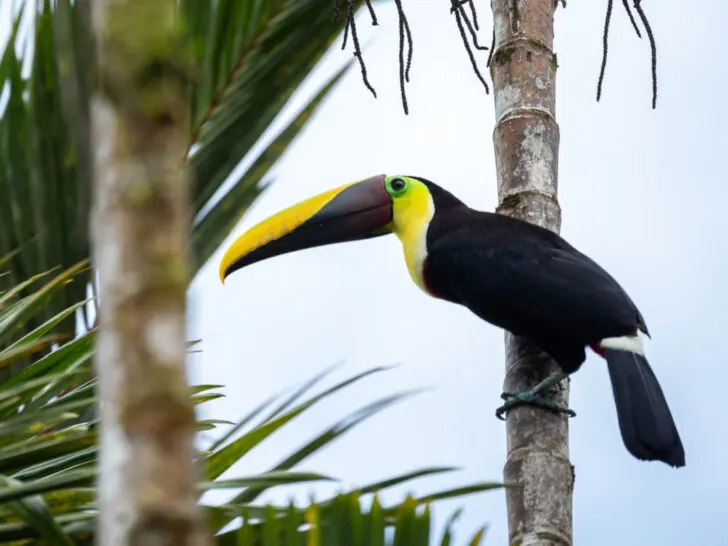
Within this wild peninsula, 2.5% of the world’s biodiversity is found. Much of it roams the 242 square kilometers (161 sq miles) of protected land within Corcovado National Park, which invites explorers to traverse dense rainforests in search of some of the country’s most elusive creatures.
Here, on treks through the rainforest, you’ll encounter exotic species like jaguars, tapirs, and all four of the monkey species found in Costa Rica, while an abundance of birds (including toucans and scarlet macaws) and reptiles. What’s more, the beaches around the peninsula are some of the wildest and most beautiful you’ll ever see.
The Osa Peninsula is a large place and you can approach it in two different ways:
- Fly to Agujitas and Bahía Drake in the north.
- Fly to Puerto Jiménez in the southeast.
Agujitas and Bahía Drake
Most visitors head to the north of the Osa Peninsula and Drake Bay (Bahía Drake), a large bay home to the laid-back little town of Aguajitas where mass tourism has yet to arrive. You’ll find a range of accommodations to fit all different budgets located here, plus tours that take you both into Corcovado National Park and the nearby Isla de Caño Biological Reserve (Reserva Biológica Isla de Caño).
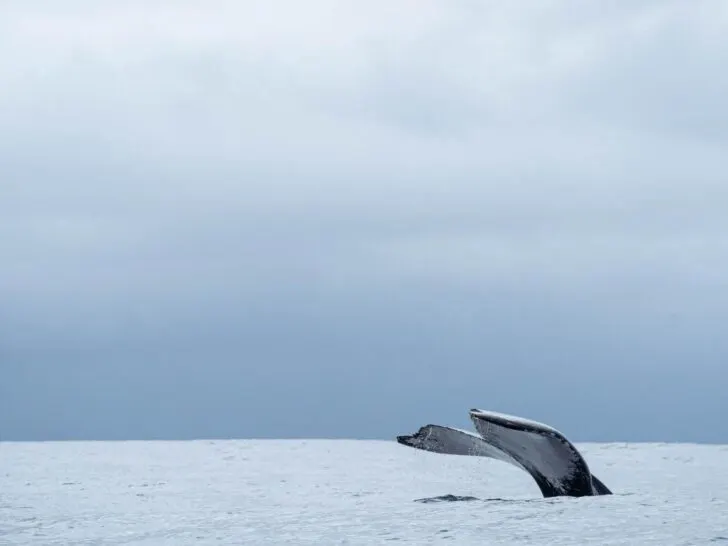
The latter – an uninhabited island with gorgeous golden sands – is a superb snorkeling spot, as you can float above an ecosystem packed with rainbow-colored coral and equally vibrant fish. It’s also a great place to spot bottlenosed dolphins, humpback whales, and various types of turtles.
Where to stay in Drake Bay
Accommodations in Drake Bay are affordable. I heard great things about Hotel Finca Maresia ($100 USD double), which is a little outside of the village, but offers wonderful hospitality, great tours into the national park, and caters for breakfast, lunch, and dinner.
Another good choice is Sunset Lodge ($80 USD double, $180 USD villa with private pool), which is much closer to the village and has wonderful sea views from the balconies of its bedrooms.
However, if you want the closest proximity to the national park – and have a big budget – consider SCP Corcovado ($1,025 USD double all-inclusive, two-night minimum), an upscale lodge situated on its fringes. It is expensive; there are no two ways about it. But, because it’s practically in the national park, I saw a lot of wildlife.
They have a family of pumas living within the grounds of the lodge (exciting and terrifying at the same time!) and, while I didn’t get to see them, they were spotted twice during the three days I was at the lodge. The curse of bad timing!
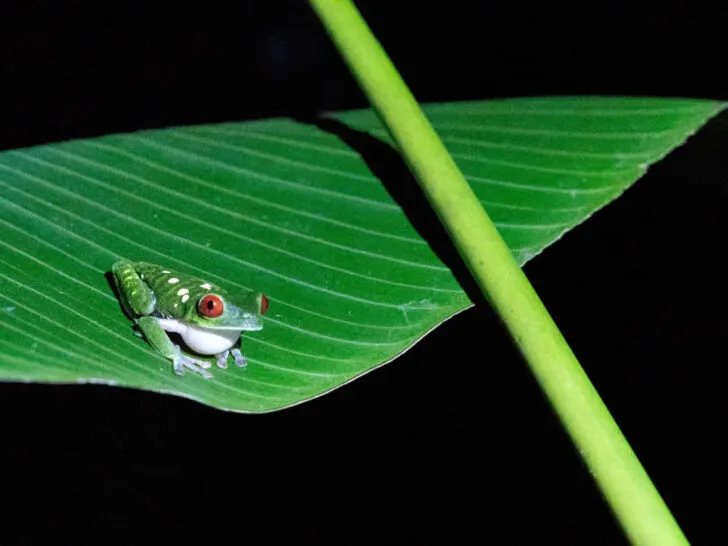
That said, I did see a tapir (very close!), red-eyed frogs, three species of monkeys, including capuchins sitting in a tree above the restaurant, plus scarlet macaws, and countless other birds. It’s a short walk to the San Pedrillo entrance, allowing for easy day trips into the park.
That said, supposedly the most plentiful wildlife-watching opportunities are from La Sirena, a ranger station only accessible by a one-day hike or motorboat. I didn’t get a chance to go, but you can do a two-day tour, with one night in the basic accommodation at the ranger station located there.
Puerto Jiménez
I preferred the south of the Osa Peninsula, which is accessible from the town of Puerto Jiménez. It’s where fewer tourists go and, if you stay at the right lodge, you might spot more wildlife than in Corcovado National Park.
The best experience to have in this part of the peninsula is to stay at one of the all-inclusive lodges. One of the best is El Remanso Rainforest Lodge ($800 USD double, all-inclusive; $1,100 USD villa with private pool; two-night minimum), a luxury hotel overlooking the ocean and within 75 hectares (185 acres) of protected jungle.
Hiking trails crisscross their reserve, which you can hike independently or, for a better chance of spotting wildlife, with one of their expert guides.
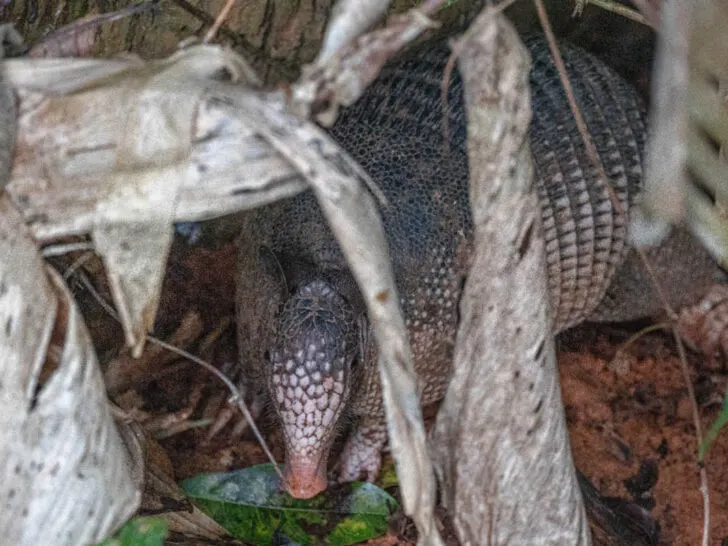
Not only did I see all four monkey species found here – howlers, white-faced capuchin, spider, and squirrel – but I spotted a red-eyed tree frog, an armadillo, a collared anteater, and, potentially, a kinkajou trotting around beneath the yoga deck.
You can still head into Corcovado National Park from here, as they offer one-day tours, entering the park at La Sirena ranger station, but they’ve also got a wealth of other things to do. Bird-watching tours beyond their reserve give me a chance to spot a rare king vulture, but you can also head out into the Golfo Dulce kayaking or whale watching.
Their villas aren’t cheap, but they’re definitely worth it. Each is tastefully designed using locally sourced and sustainably farmed wood and mosquito nets rather than walls along one side – giving you a feeling of being right inside the rainforest.
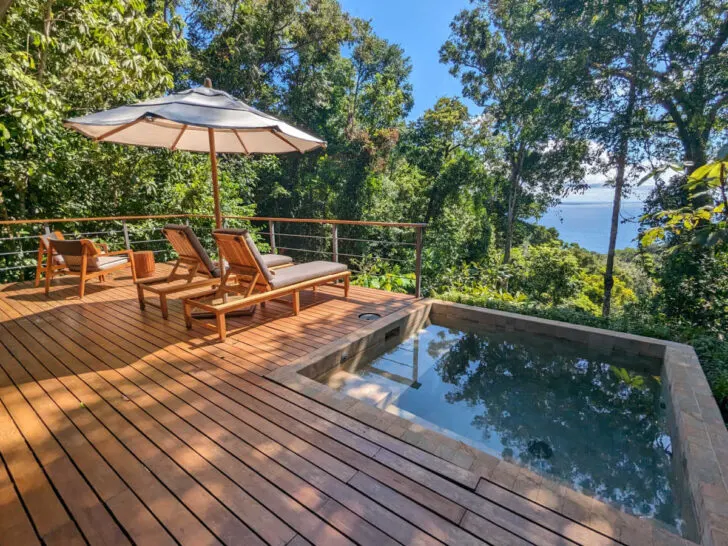
If you want ultra-luxury, opt for a villa with a plunge pool – although all rooms have access to an ocean-facing swimming pool. The lodge is all-inclusive and the restaurant (also with ocean views) will cook you up some of the tastiest food you’ll have in your entire week in Costa Rica.
Day Four: La Fortuna
Hop back on a plane to San José (50 minutes) and then hire a car to drive to La Fortuna (3.5 hours), a town on the eastern side of Volcán Arenal, an almost perfectly symmetrical stratovolcano located within its namesake national park.
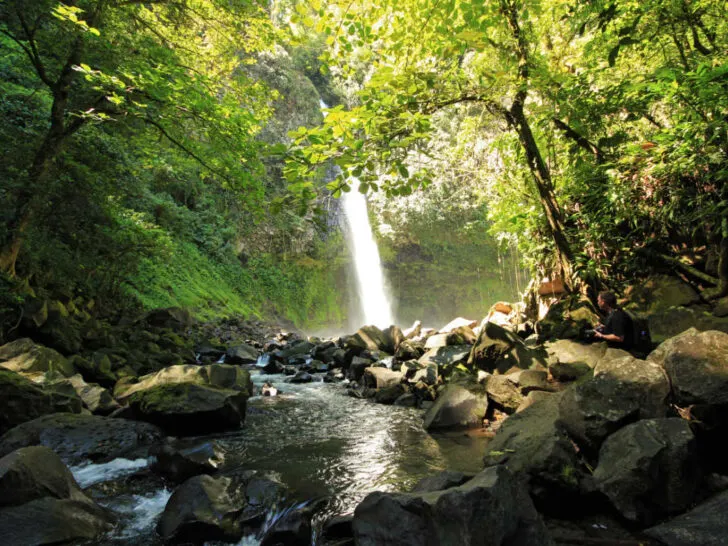
If you’ve got time this afternoon, head to one of the thermal springs on the northern edge of Lago Arenal, such as the plush Ecotermales Fortuna ($47 USD), a complex of five hot pools ranging from 32°C (90°F) to 41°C (106°F) in temperature.
Stay in La Fortuna, which is a small town but has plenty of hotels and restaurants.
Where to stay in La Fortuna
I suggest Arenal Xilopalo ($60 USD double), a small guesthouse that’s just a five-minute walk from town but feels tucked away. Views from the onsite restaurant of the volcano are remarkable and there’s a welcome pool for hot days.
Itinerary extension
If you want to slow down a bit and give yourself more opportunity to enjoy the area around La Fortuna, consider adding a few days at Rancho Margot ($335 USD double, minimum two nights, all-inclusive).
This self-sufficient, carbon-neutral eco-resort has cute bungalows and spring-fed swimming pools and is set within beautiful organic gardens, where you can learn about their approach to sustainability and take part in workshops to make everything from cheese to chocolate and soap. They operate tours to go kayaking on Lago Arenal, as well as hikes around the grounds, and horseback riding up into the hills for beautiful views of the Arenal Volcano.
You can also use it as a base for exploring Parque Nacional Volcan Arenal (Arenal Volcano National Park).
Day Five: Caño Negro Wildlife Refuge
From La Fortuna, take a tour to Caño Negro Wildlife Refuge (Refugio Nacional de Vida Silvestre Caño Negro) in the north; alternatively, you can drive directly to the village of Caño Negro, where you can organize a tour directly.
Situated in the northern lowlands on the border with Nicaragua, the little-known Caño Negro is an important wetland that draws local and migratory birds in their droves.
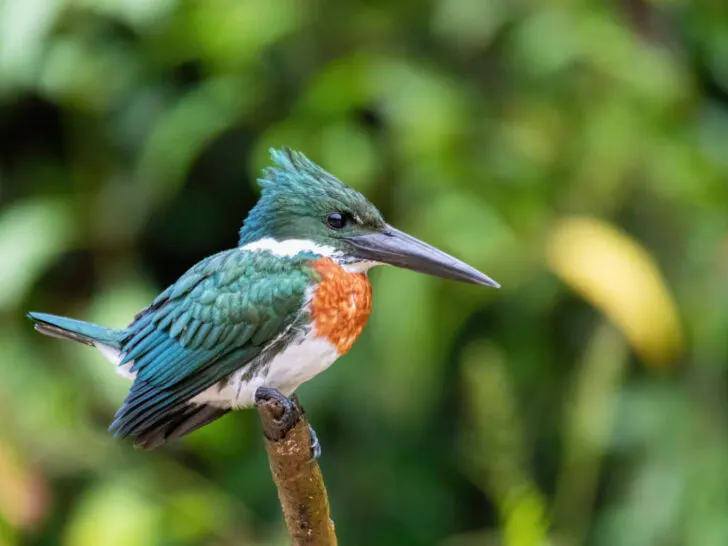
Your tour will take you on a river cruise along the Río Frío, where caimans lurk, iguanas bask, and howler monkeys roar from the trees above. However, most visitors come for the birds, as these wetlands host myriad species, including agami herons, pygmy kingfishers, and the endangered jabiru stork.
Between May and November, the rainy season, the river floods to become a 1,980-acre (three sq-mile) lagoon, where it becomes a wintering site for migratory birds from North America. During the dry season (December through April), the river shrinks to small lagoons; these months are the best for seeing the majority of birds.
Return to La Fortuna and your hotel.
Day Six: La Fortuna to Santa Elena and the Monteverde Cloud Forest
While Santa Elena is only a few kilometers south of La Fortuna as the crow flies, there’s no direct driving route between the two.
To give you more time to explore the cloud forests around Santa Elena, start early and head due west along the skirts of Lago Arenal before heading south through Puerto Nueva and cutting cross-country to Santa Elena.
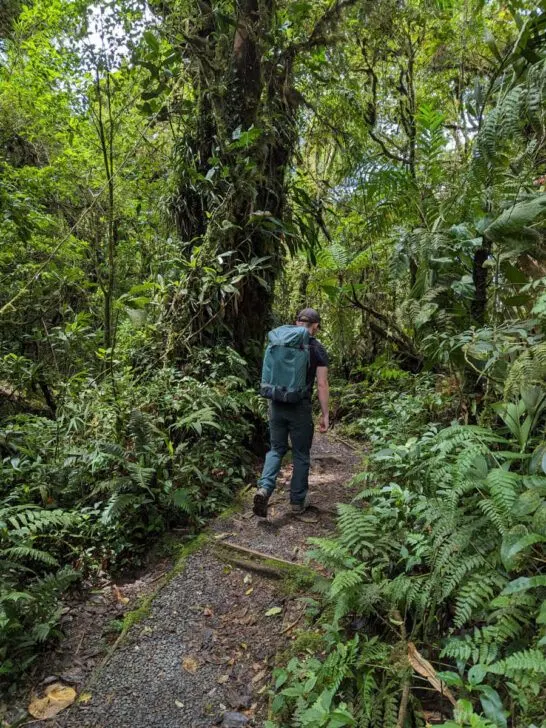
The road is in very poor condition, with plenty of potholes and gravel sections, so take your time and enjoy the views. Expect the drive to take between 3.5 and four hours.
Insider tip: Don’t be tempted to take the road along the southern edge of the lake. This is only passable with 4WD during the rainy season.
Visiting Costa Rica’s cloud forest is a surreal experience. When you reach Santa Elena, I recommend stopping for a quick lunch at El Sapo, a great restaurant with beautiful views across the hills.
Afterward, drive to Monteverde Cloud Forest Reserve (Bosque Nubloso Monteverde), one of Costa Rica’s star attractions. It’s exactly as its name suggests: a forest above which clouds hang continuously and they’re both rare and home to a high level of biodiversity.
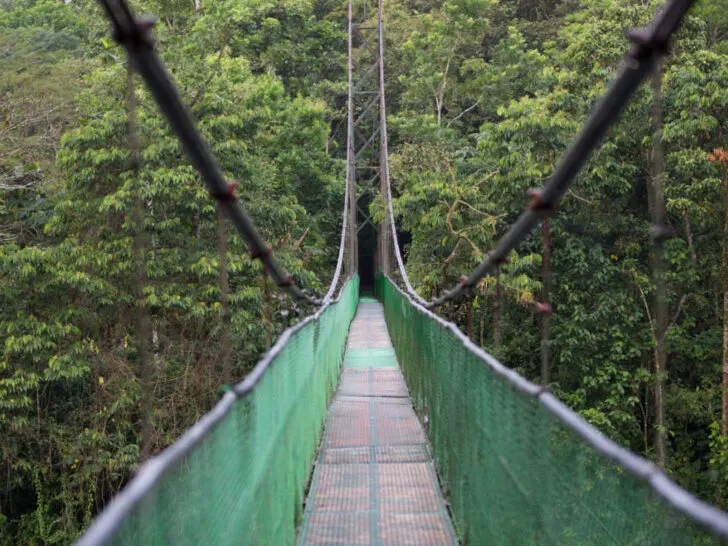
You’ll want to make the most of this unique ecosystem by heading to the park’s suspension bridges, set high up in the forest canopy, to quite literally walk through the clouds.
You’ll also find over 13 kilometers (eight miles) of trails to explore, although if you want to understand the ecosystem and have a better chance of spotting wildlife, I’d recommend joining a tour – you can organize one directly at the park’s entrance.
As the sun sets, join a nocturnal wildlife tour to try and encounter the forests’ more elusive species, including the red-eyed tree frog, anteaters, and armadillos.
Alternatively, if you’re not bothered about the suspension bridges and want to truly escape the crowds, take yourself to Santa Elena Cloud Forest Reserve (Reserva Bosque Nuboso Santa Elena), whose trails are less touristy and wilder.
Stay overnight in Santa Elena, which is larger than the village of Monteverde and has a good range of accommodations and restaurants.
Where to stay in Santa Elena
I stayed at Cloud Forest Lodge ($332 USD double), which was overpriced (even if the food was brilliant).
Instead, l would highly recommend Hidden Canopy Treehouses ($329 USD double), which I heard was brilliant from multiple people. It’s a boutique hotel with six treehouses sitting high up in the treetops (which allows you to practically eyeball the wildlife that turns up at your windows!). The hospitality is supposed to be excellent, too.
Day Seven: Monteverde
You’ll want to rise early today for a dawn tour of the cloud forest and a chance to spot the resplendent quetzal, one of the region’s most colorful birds. While Monteverde is the best-known place to do so, to escape the crowds, head instead to Reserva Curi-Cancha (Curi-Cancha Reserve), which receives significantly fewer visitors but is home to plenty of wildlife.
Quetzals are rightfully the prize species to see here. Your likelihood of seeing one is enhanced by two factors: going with a tour guide (their eagle eyes are crucial for this) and the time of the year.
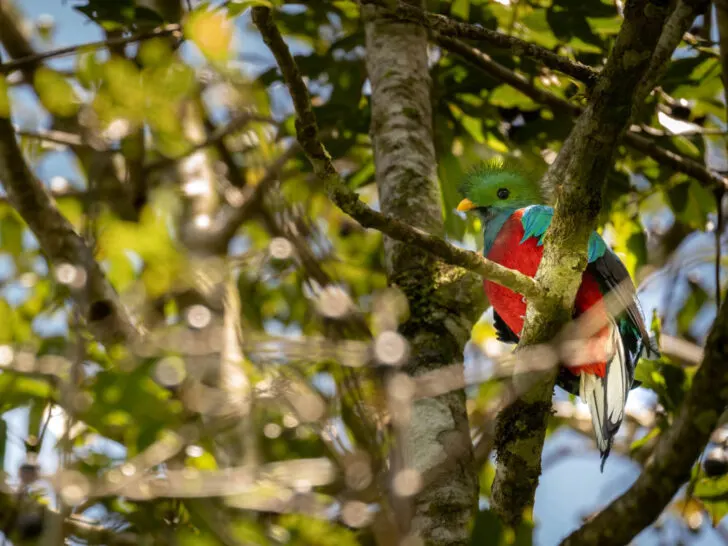
The breeding season (February through July) is when they’re easiest to spot, but we had luck in September. Most have a specific location where they breed, as well as a penchant for avocado trees, which means your guide should easily be able to locate them, even in the vast forest.
Drive back to San José (again, the 606 heading south of Santa Elena road is in a very poor state until you hit Ruta 1) and take your flight home.
Seven-day itinerary: Costa Rica off the beaten path
This seven-day Costa Rica itinerary is for those seeking to escape the crowds and discover Costa Rica beyond its most famous destinations.
You’ll also experience a good mix of adventure and wildlife and spend longer in each location than some of the other itineraries – after all, slow travel is the way to truly experience a place.
- Days One to Three: The Pacuare River
- Days Four to Seven: The Osa Peninsula
Days One to Three: The Pacuare River
Fringed with primary rainforest and offering some of Costa Rica’s – if not the world’s – best white water rafting, the Pacuare River is a magical place to spend a few days. What’s more, the adventure begins before you even arrive at your lodge: the only way in and out is by water.
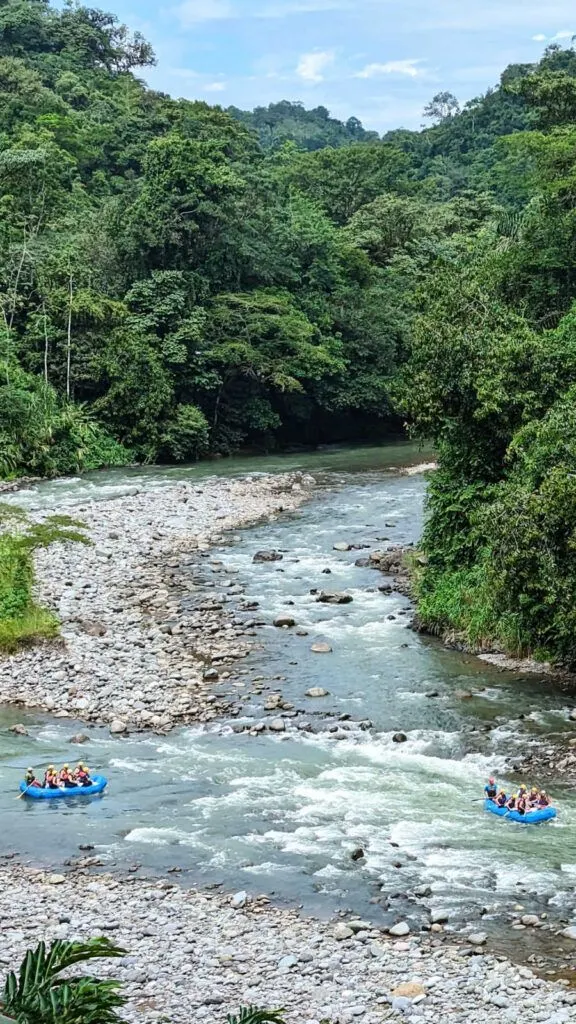
Get a 10% discount off a trip to the Pacuare River
Rios Lodge is one of the leading eco lodges along the Pacuare River and has helped drive the sustainability efforts that have protected the surrounding jungle.
The team of rafting guides are brilliant, the views from bedrooms across the river mesmorizing, and the food some of the best I ate in Costa Rica.
They’re offering a 10% discount on the price of the lodge for all Worldly Adventurer readers. Just use the code wa10 when booking.
Never tried whitewater rafting before? Don’t worry: you’re in safe hands, with an expert rafting guide who will take you downstream. And, it’s a thrill to bounce through Class I to V rapids past the region’s astoundingly beautiful scenery of rainforest and tumbling waters.
You’ve got a good chance of spying monkeys and kingfishers in the riverbanks and otters in the water below.
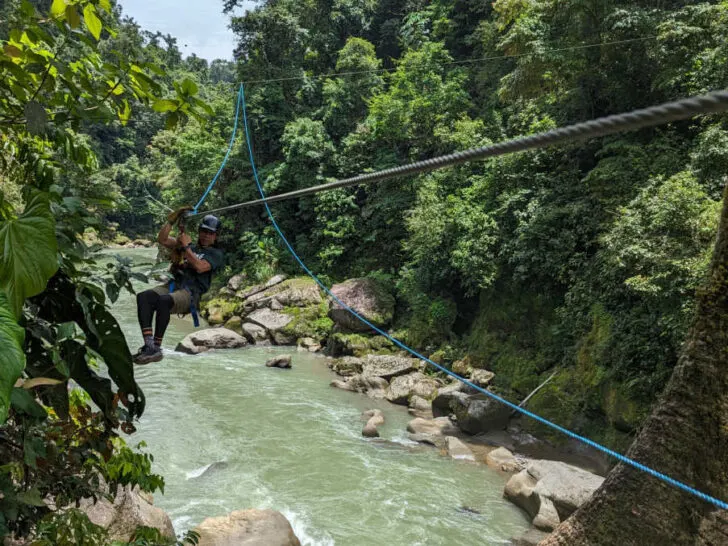
Your lodge will provide transportation from the capital to the put-in (aka where you enter the water), from where it’s an exhilarating two to three-hour paddle down gentle Class I and II rapids to reach your lodge.
On the way out, you’ll also raft the lower Pacuare Gorge. This section of the river with its class III-IV rapids was described by National Geographic as one of the top three rafting courses in the world.
Where to stay along the Pacuare River
I stayed at Rios Lodge (from $925 USD double all-inclusive for two nights; $50 USD pp dorm per night; get a 10% discount off your stay at Rios Lodge using the code wa10 when booking), one of the most established lodges along the Pacuare River. It’s set within 90 acres of reforested land – Rafa Gallo, the original owner was a pioneer when it came to conservation and sustainable tourism.
Sadly, Rafa passed away in 2021 and the lodge, following a complete refurbishment, reopened last year under the stewardship of a group of paddlers and conservationists (and Rafa’s son, Roberto). It still remains committed to sustainability, running fully on hydro energy and with plans to buy up further land that can be reforested.
Accommodation comprises light and airy bedrooms built from sustainably sourced cypress wood, most with large balconies overlooking the tumbling river. For smaller budgets, book a bed in their brand-new hostel.
Both types of accommodation include food from their excellent restaurant, while there’s even a yoga deck where you can find a sense of peace surrounded by the relaxing noises of the river and jungle.
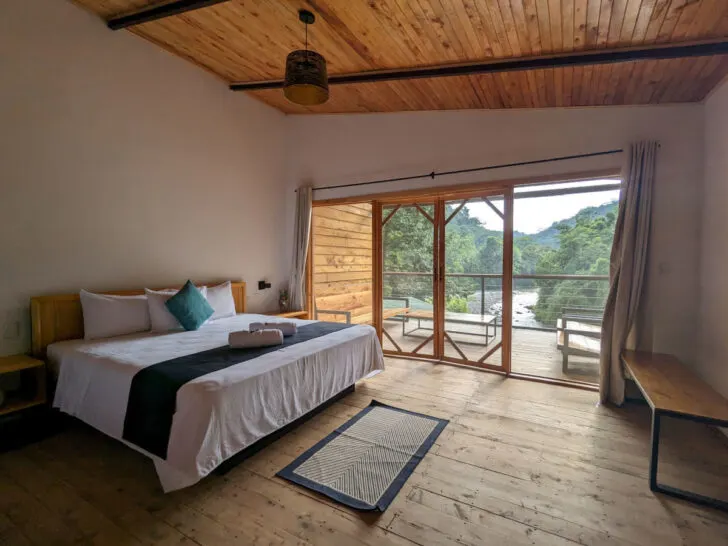
All guests can try out the lodge’s thrilling eight-zipline course, which crisscrosses the river for breathtaking views, while horseback riding, tubing, and waterfall hikes can be arranged directly with the lodge.
At the end of day three, once you’ve rafted out, your lodge will take you back to San José. Accommodations in San José are basic, to say the least. With pool access, the modern – albeit slightly characterless – Studio Hotel Boutique ($118 USD double) is a good choice.
For homespun charm, the family-run Casa 69 San José ($78 USD double) tops my list.
Days Four to Seven: The Osa Peninsula
From the Costa Rican capital, San José, hop in a 10-seater Cessna aircraft from the domestic airport for the 50-minute flight south to the Osa Peninsula.
The views as you follow the edges of the Pacific Coast and then soar above Corcovado National Park (Parque Nacional Corcovado) beneath are astounding. Keep your eyes peeled for whales in the ocean – I saw one breach!
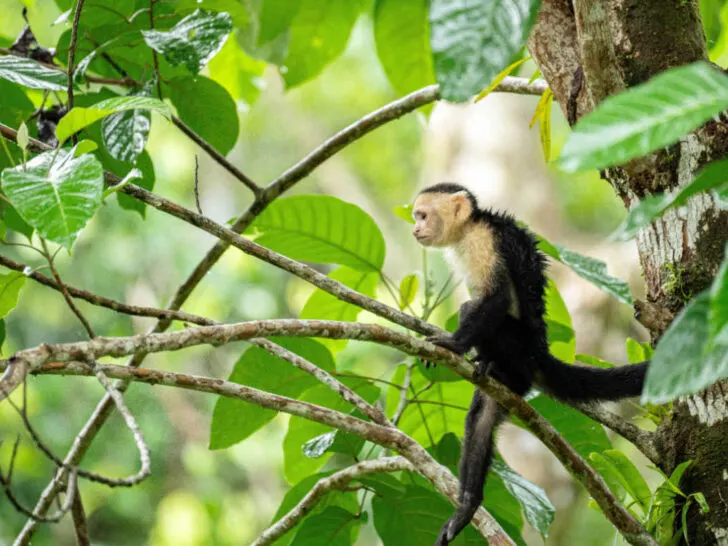
Within this wild peninsula, 2.5% of the world’s biodiversity is found. Much of it roams the 242 square kilometers (161 sq miles) of protected land within Corcovado National Park, which invites explorers to traverse dense rainforests in search of some of the country’s most elusive creatures.
Here, on treks through the rainforest, you’ll encounter exotic species like jaguars, tapirs, and all four of the monkey species found in Costa Rica, while an abundance of birds (including toucans and scarlet macaws) and reptiles. What’s more, the beaches around the peninsula are some of the wildest and most beautiful you’ll ever see.
The Osa Peninsula is a large place and you can approach it in two different ways:
- Fly to Agujitas in Bahía Drake in the north.
- Fly to Puerto Jiménez in the southeast.
Agujitas and Bahía Drake
Most visitors head to the north of the Osa Peninsula and Drake Bay (Bahía Drake), a large bay home to the laid-back little town of Aguajitas where mass tourism has yet to arrive.
You’ll find a range of accommodations to fit all different budgets located here, plus tours that take you both into Corcovado National Park and the nearby Isla de Caño Biological Reserve (Reserva Biológica Isla de Caño).
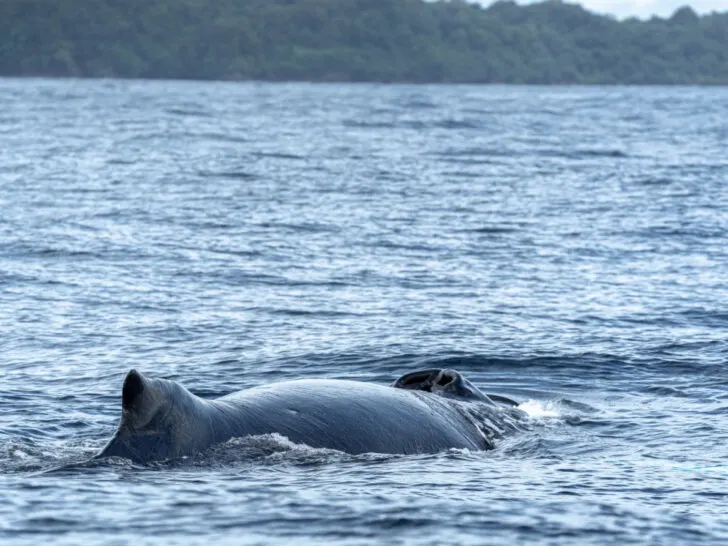
The latter – an uninhabited island with gorgeous golden sands – is a superb snorkeling spot, as you can float above an ecosystem packed with rainbow-colored coral and equally vibrant fish. It’s also a great place to spot bottlenosed dolphins, humpback whales, and various types of turtles.
Where to stay in Drake Bay
Accommodations in Drake Bay are affordable. I heard great things about Hotel Finca Maresia ($100 USD double), which is a little outside of the village, but offers wonderful hospitality, great tours into the national park, and caters for breakfast, lunch, and dinner.
Another good choice is Sunset Lodge ($80 USD double, $180 USD villa with private pool), which is much closer to the village and has wonderful sea views from the balconies of its bedrooms.
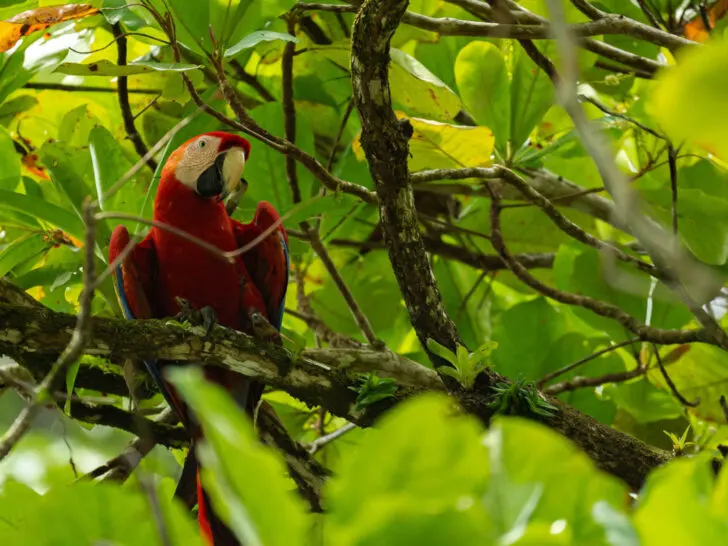
However, if you want the closest proximity to the national park – and have a big budget – consider SCP Corcovado ($1,025 USD double all-inclusive, two-night minimum), an upscale lodge situated on its fringes. It is expensive; there are no two ways about it. But, because it’s practically in the national park, I saw a lot of wildlife.
They have a family of pumas living within the grounds of the lodge (exciting and terrifying at the same time!) and, while I didn’t get to see them, they were spotted twice during the three days I was at the lodge. The curse of bad timing!
That said, I did see a tapir (very close!), red-eyed frogs, three species of monkeys, including capuchins sitting in a tree above the restaurant, plus scarlet macaws, and countless other birds. It’s a short walk to the San Pedrillo entrance, allowing for easy day trips into the park.
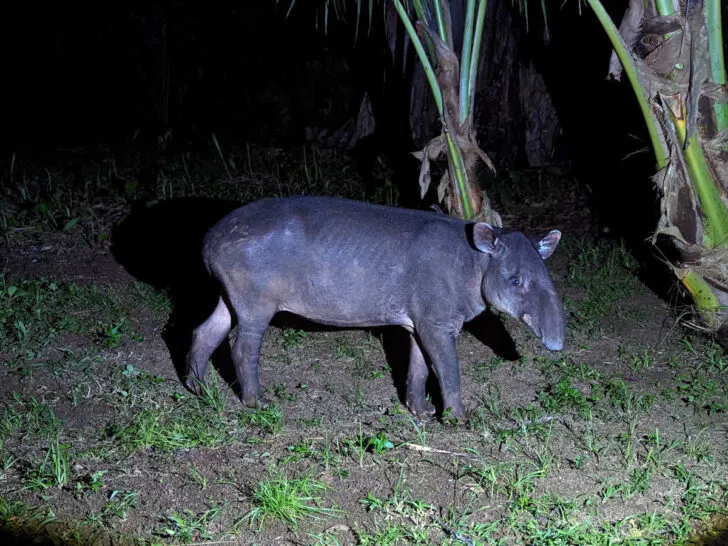
That said, supposedly the most plentiful wildlife-watching opportunities are from La Sirena, a ranger station only accessible by a one-day hike or motorboat. I didn’t get a chance to go, but you can two a two-day tour, with one night in the basic accommodation at the ranger station located there.
Puerto Jiménez
I preferred the south of the Osa Peninsula, which is accessible from the town of Puerto Jiménez. It’s where fewer tourists go and, if you stay at the right lodge, you might spot more wildlife than in Corcovado National Park.
The best experience to have in this part of the peninsula is to stay at one of the all-inclusive lodges. One of the best is El Remanso Rainforest Lodge ($800 USD double, all-inclusive; $1,100 villa with private pool; two-night minimum), a luxury hotel overlooking the ocean and within 75 hectares (185 acres) of protected jungle.
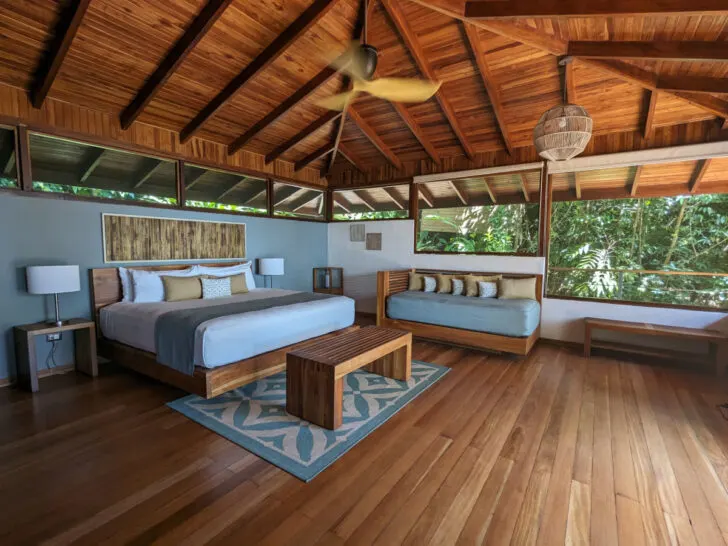
Hiking trails crisscross their reserve, which you can hike independently or, for a better chance of spotting wildlife, with one of their expert guides.
Not only did I see all four monkey species found here – howlers, white-faced capuchin, spider, and squirrel – but I spotted a red-eyed tree frog, an armadillo, a collared anteater, and, potentially, a kinkajou trotting around beneath the yoga deck.
You can still head into Corcovado National Park from here, as they offer one-day tours, entering the park at La Sirena ranger station, but they’ve also got a wealth of other things to do. Bird-watching tours beyond their reserve give me a chance to spot a rare king vulture, but you can also head out into the Golfo Dulce kayaking or whale watching.
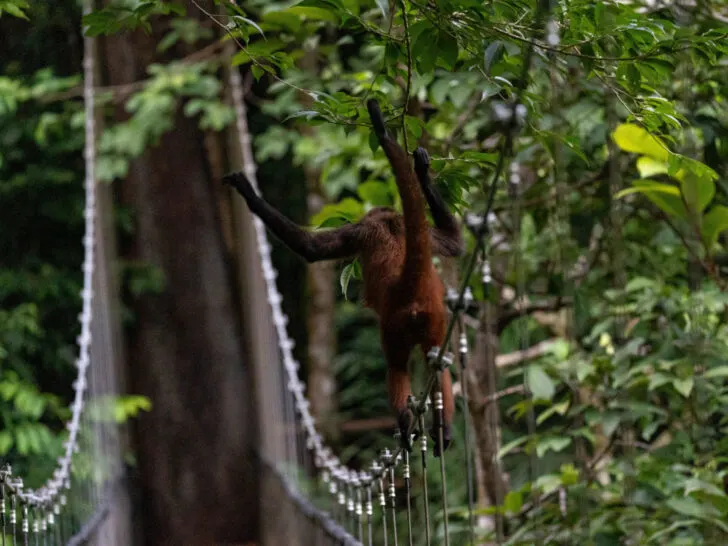
Their villas aren’t cheap, but they’re definitely worth it. Each is tastefully designed using locally sourced and sustainably farmed wood and mosquito nets rather than walls along one side – giving you a feeling of being right inside the rainforest.
If you want ultra-luxury, opt for a villa with a plunge pool – although all rooms have access to an ocean-facing swimming pool. The lodge is all-inclusive and the restaurant (also with ocean views) will cook you up some of the tastiest food you’ll have in your entire week in Costa Rica.
On your final day, take a 50-minute flight back to San José and your return flight home.
Seven days in Costa Rica for adventure seekers
Want to see the most adventurous side of Costa Rica? It’s no wonder that travelers flock to this country to not just kick back and relax but to enjoy its high-adrenaline adventures.
With everything from world-class whitewater rafting to hiking through volcano-dotted landscapes, and surfing some of the Pacific’s finest swells, Costa Rica is a prime destination for an active vacation.
- Days One to Three: The Pacuare River
- Days Four and Five: Rincón de la Vieja
- Days Six and Seven: The Nicoya Peninsula
Days One to Three: The Pacuare River
Fringed with primary rainforest and offering some of Costa Rica’s – if not the world’s – best white water rafting, the Pacuare River is a magical place to spend a few days. What’s more, the adventure begins before you even arrive at your lodge: the only way in and out is by water.
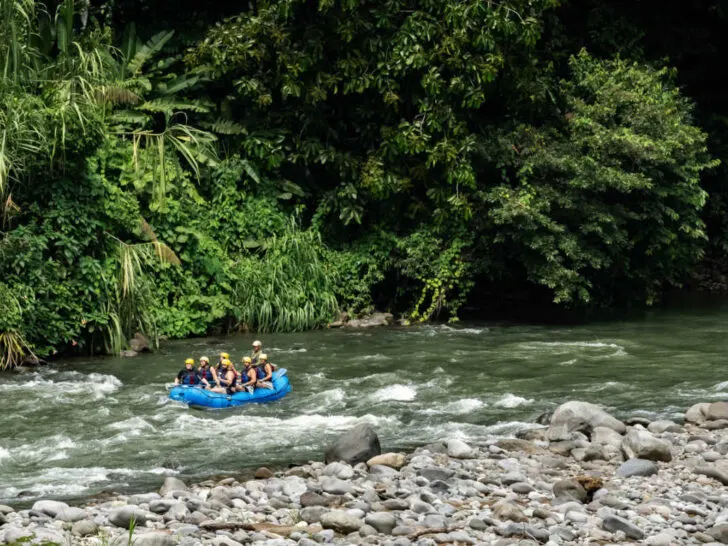
Never tried whitewater rafting before? Don’t worry: you’re in safe hands, with an expert rafting guide who will take you downstream. And, it’s a thrill to bounce through Class I to V rapids past the region’s astoundingly beautiful scenery of rainforest and tumbling waters. You’ve got a good chance of spying monkeys and kingfishers in the riverbanks and otters in the water below.
Your lodge will provide transportation from the capital to the put-in (aka where you enter the water), from where it’s an exhilarating two to three-hour paddle down gentle Class I and II rapids to reach your lodge.
On the way out, you’ll also raft the lower Pacuare Gorge. This section of the river with its class III-IV rapids was described by National Geographic as one of the top three rafting courses in the world.
Where to stay along the Pacuare River
I stayed at Rios Lodge, one of the most established lodges along the Pacuare River. It’s set within 90 acres of reforested land – Rafa Gallo, the original owner was a pioneer when it came to conservation and sustainable tourism.
Sadly, Rafa passed away in 2021 and the lodge, following a complete refurbishment, reopened last year under the stewardship of a group of paddlers and conservationists (and Rafa’s son, Roberto). It still remains committed to sustainability, running fully on hydro energy and with plans to buy up further land that can be reforested.
Accommodation comprises light and airy bedrooms built from sustainably sourced cypress wood, most with large balconies overlooking the tumbling river. For smaller budgets, book a bed in their brand-new hostel.
Both types of accommodation include food from their excellent restaurant, while there’s even a yoga deck where you can find a sense of peace surrounded by the relaxing noises of the river and jungle.
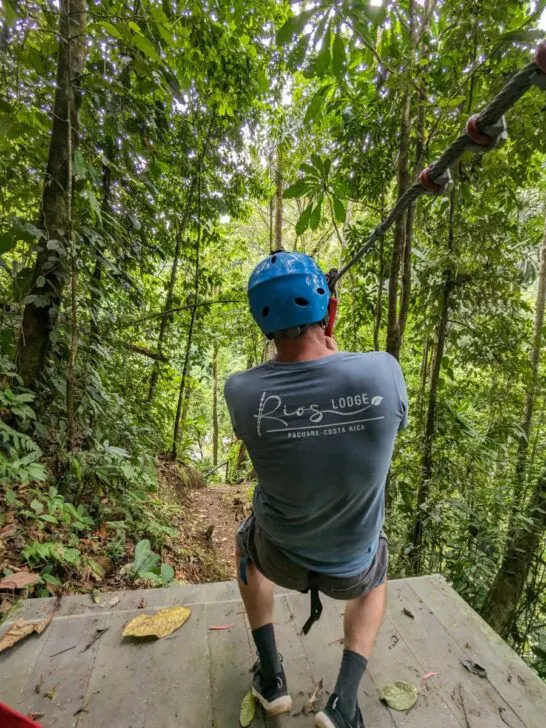
All guests can try out the lodge’s thrilling eight-zipline course, which crisscrosses the river for breathtaking views, while horseback riding, tubing, and waterfall hikes can be arranged directly with the lodge.

Get a 10% discount off a trip to the Pacuare River
Rios Lodge is one of the leading eco lodges along the Pacuare River and has helped drive the sustainability efforts that have protected the surrounding jungle.
The team of rafting guides are brilliant, the views from bedrooms across the river mesmorizing, and the food some of the best I ate in Costa Rica.
They’re offering a 10% discount on the price of the lodge for all Worldly Adventurer readers. Just use the code wa10 when booking.
At the end of day three, once you’ve rafted out, your lodge will take you back to San José. Accommodations in San José are basic to say the least. With pool access, the modern – albeit slightly characterless – Studio Hotel Boutique ($118 USD double) is a good choice.
For homespun charm, the family-run Casa 69 San José ($78 USD double) tops my list.
Days Four and Five: Rincón de la Vieja
Take an early morning flight from the domestic terminal at San José Mineta International Airport to Daniel Oduber Quirós International Airport (45 mins), just outside of the city of Liberia in Guanacaste, a province in the northwest of Costa Rica.
Hire a car and drive to Rincón de la Vieja National Park (Parque Nacional Rincón de la Vieja), a 1.5-hour drive northeast.
With some of the best hiking in the country, Rincón de Vieja National Park has a glut of trails winding through spectacular, contrasting scenery of tropical forest packed with wildlife and sparse, rocky savannah – over which the park’s namesake volcano, and a handful of other fiery peaks, loom over.
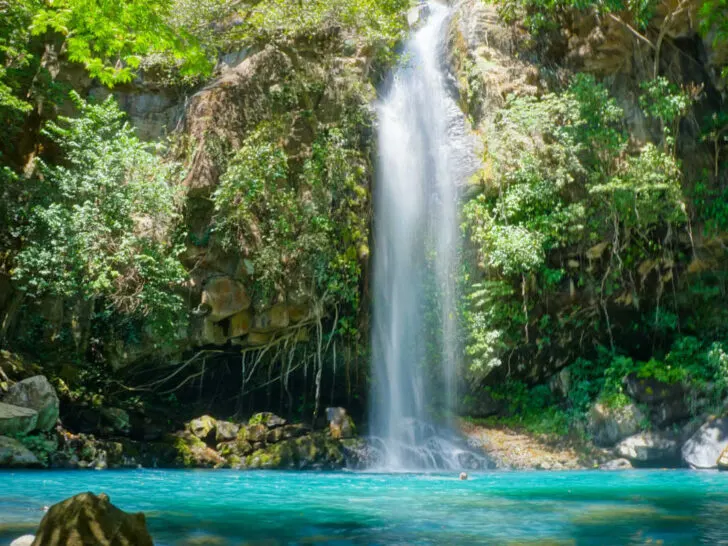
Hit the trails with a hike up to the crater of the Rincón de Vieja volcano. It’s a steep, eight-kilometer (five-mile) path to its summit, from where you can observe the shimmering turquoise waters of Lago los Jilgueros, the lake in the crater, and perhaps even catch beautiful views of Lago de Nicaragua across the border if it’s a clear day.
Keep your eyes peeled for wildlife; you’ve got a chance of spotting everything from two-toed sloths to plenty of different monkey species and, if you’ve got remarkable luck, tapir and collared peccary. Birds are also in abundance here.
More of a fan of exploring on two wheels? Mountain biking is another bike draw here, with plenty of local companies allowing you to whizz through the forest.
Thanks to the park’s geothermal energy, mud baths and hot springs are other star attractions. For a day’s natural spa, head to the Río Negro hot springs ($30 USD), which lie just outside of the national park. You’ll need to purchase a ticket in advance here.
Stay overnight in a lodge close to Las Pailas ranger station, which is the best entry point into the park.
Where to stay near Rincón de la Vieja
High-end Borinquen Mountain Resort ($243 USD double), which sits on the fringes of the volcano, has villas, a brilliant restaurant, thermal pools, and a swimming pool.
Alternatively, Rinconcito Lodge ($130 USD double) has large doubles with garden views and hammock-slung porches. There’s also a very welcome swimming pool and great breakfast (although it costs extra, so make sure you add it to your booking!). There’s not much else nearby, so you’ll likely want to make use of their restaurant for dinner, too.
Days Six and Seven: The Nicoya Peninsula
Costa Rica’s Pacific coast boasts some of the best surfing in Central America, thanks to reliable swells that offer up beach breaks. Thanks to the country’s pura vida (the good life) mantra, the beach towns along the coast of Guanacaste promise not only alluring surf but a chance to kick back and relax, too.
From Rincón de la Vieja, you’ve got a couple of choices for where to spend your final few days. Tamarindo, on the north of the Nicoya Peninsula, is one of Costa Rica’s best-known surfing destinations. Since it featured in the surfing film Endless Summer II in 1991, Tamarindo has become the country’s hottest place to catch a wave.
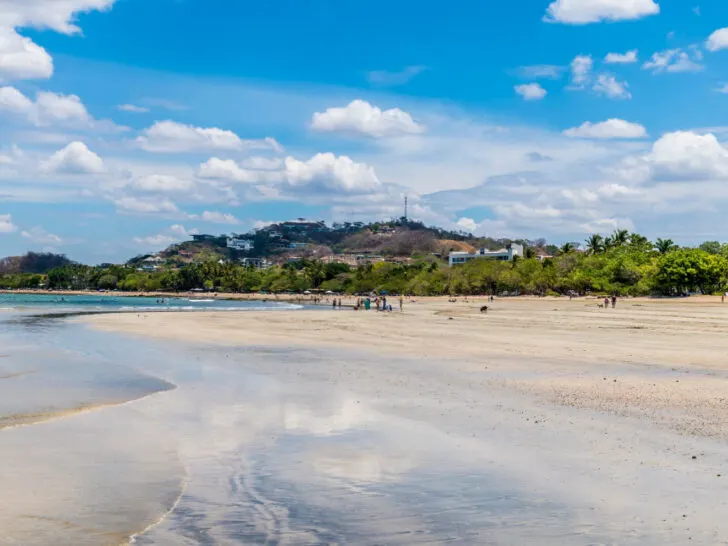
Everyone from absolute beginners to intermediate surfers will find a break to enjoy here – while the town’s lively nightlife will appeal to those seeking to blow off some steam. That said, Tamarindo lacks much of the local personality of the rest of Costa Rica, with characterless malls and more tourists than local people.
Sound like it’s not your thing? If you’re keen on surf and want to get away from the crowds, head instead to Santa Rosa National Park (Parque Nacional Santa Rosa). Costa Rica’s oldest national park is also one of its most unusual, protecting one of the last remaining tracts of tropical dry forest on the planet, alongside mangrove swamps and deciduous forests.
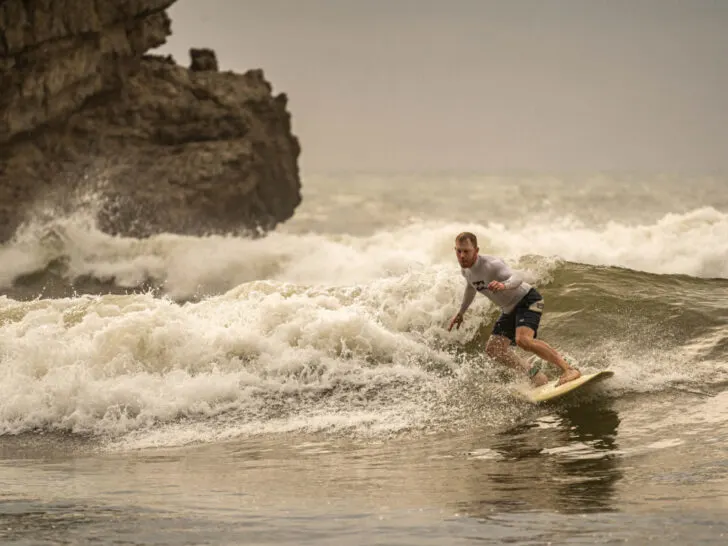
Playa Naranjo is where you’ll find the finest surf – and was also featured in Endless Summer II. However, more complicated access (it can be reached only by 4WD) and little accommodation (only camping), means it’s far less popular than beaches further south.
And, if you’re visiting between July and November, it’s worth heading to Playa Nancite to catch sight of the incredible phenomenon that is olive ridley turtles laying eggs on the beach at night. They descend in their thousands, typically around the new moon, to dig a nest, lay eggs, and then trundle back off into the water.
Camp in the national park (you’ll need your own gear) or stay in Playa Copal, a town north, where you’ll also find the country’s best kitesurfing and plenty of companies offering lessons.
On the final day, drive back to Daniel Oduber Quirós International Airport and take a flight back to San José and your flight home.
Ready to start planning your trip to Costa Rica? Find more inspiration with the 15 Best Places to Visit for First-Timers. Guanacaste on your list? Here’s what you need to know about the Best Time to Visit Guanacaste. If you’re considering a trip exploring more of South America, discover the 31 Best Places to Visit in South America here.
